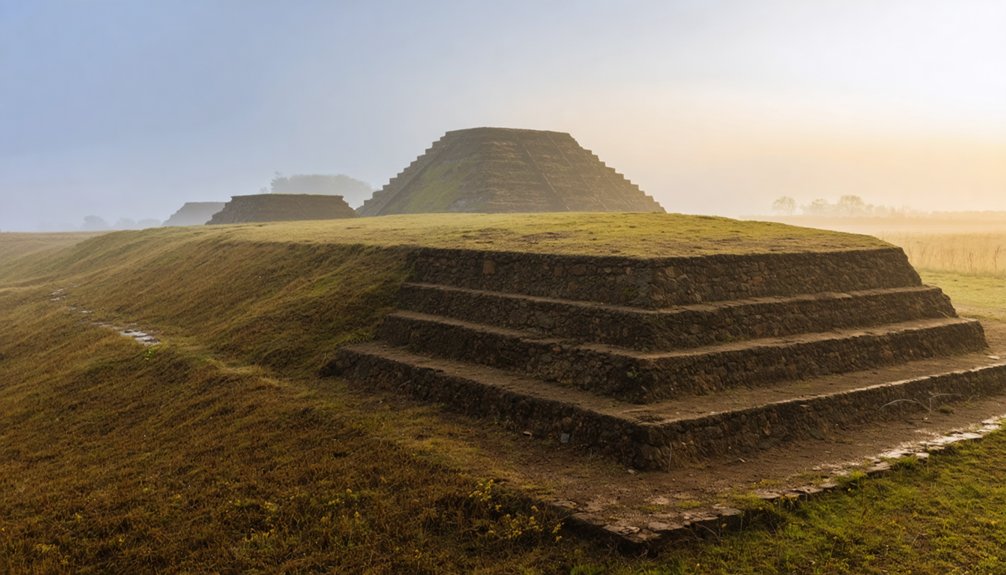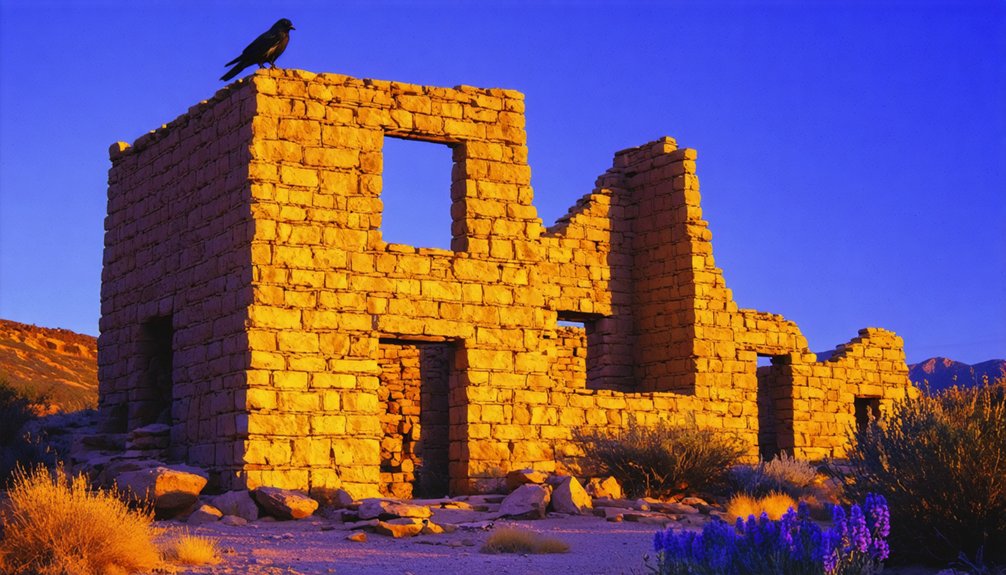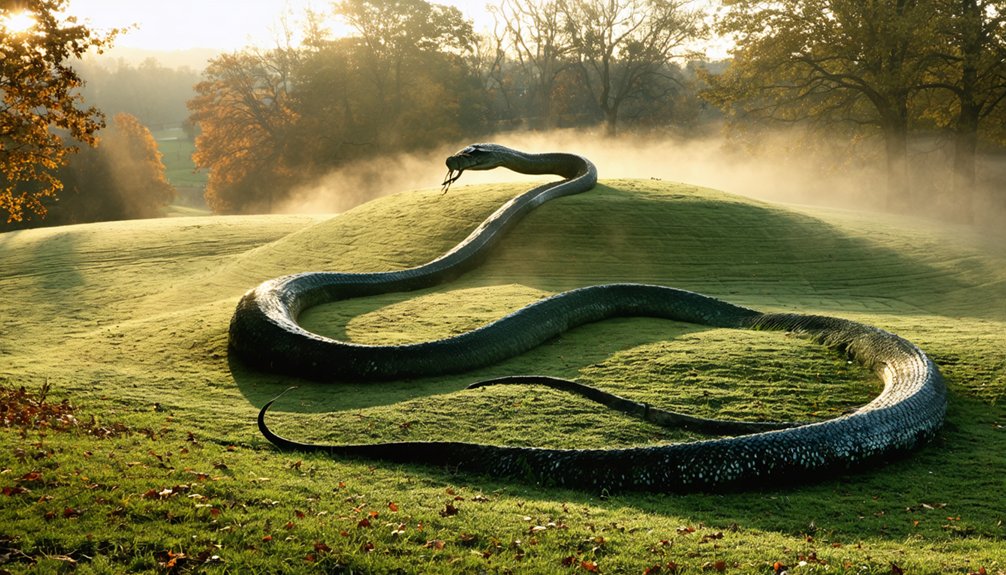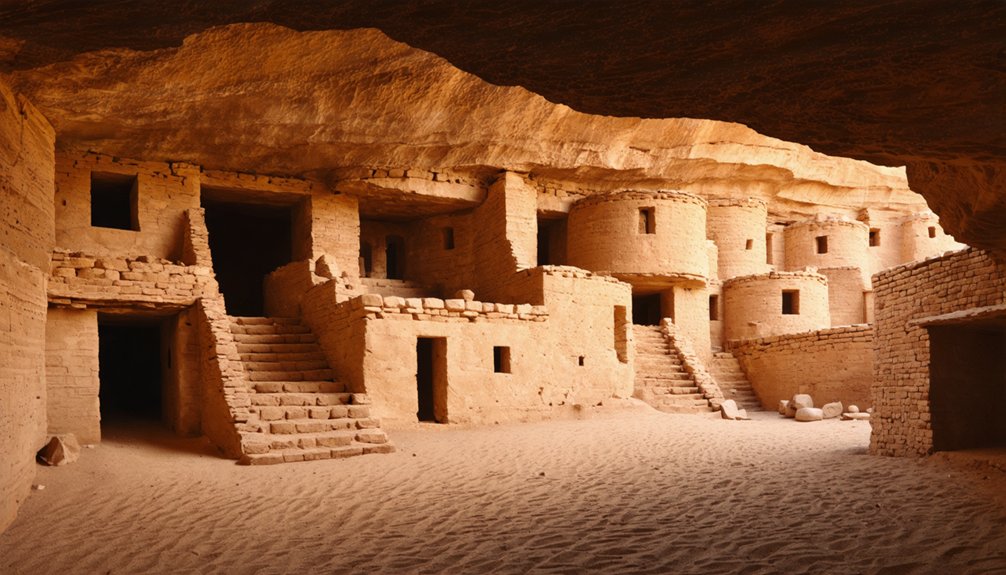You’ll discover remarkable Native American ruins across America, from Louisiana’s 402-acre Poverty Point earthworks to the cliff dwellings of Mesa Verde. These sites include Chaco Canyon’s massive great houses, Cahokia’s 100-foot Monks Mound, and the mysterious Casa Grande in Arizona. Other significant monuments include Aztec Ruins, Hovenweep’s towers, Ocmulgee’s sacred mounds, and Ohio’s Great Serpent Mound. Each site offers compelling evidence of sophisticated ancient civilizations that thrived through complex trade networks and architectural innovation.
Key Takeaways
- Mesa Verde’s Cliff Palace contains 150 rooms carved into alcoves, demonstrating sophisticated architectural skills of Ancient Puebloans.
- Poverty Point features massive earthworks across 402 acres, serving as a major ceremonial and trade center from 1700-1100 BCE.
- Cahokia was North America’s largest pre-Columbian city, housing 20,000 residents and featuring the 100-foot-high Monks Mound.
- Chaco Canyon’s Pueblo Bonito complex showcases monumental stone architecture and served as a hub for turquoise trade networks.
- Gila Cliff Dwellings contain 42 rooms with three Great Kivas, representing the spiritual and communal life of Mogollon people.
The Ancient City of Poverty Point: Louisiana’s Earthen Legacy
Among North America’s most remarkable prehistoric monuments, Poverty Point stands as a demonstration of the engineering prowess of Late Archaic indigenous peoples.
You’ll find this 402-acre site dominated by massive earthworks, including six concentric ridges and Mound A, one of the continent’s largest earthen mounds. Built between 1700-1100 BCE, it served as both a ceremonial center and a thriving trade hub for hunter-gatherer societies who achieved monumental landscape modification without agricultural technology.
Ancient hunter-gatherers transformed 402 acres into a ceremonial complex of earthen mounds, proving their ability to reshape landscapes without agriculture.
The site maintained a diet rich in local game and nuts, with inhabitants relying on hunting, fishing, and gathering rather than farming. Some mounds were crafted into bird effigy shapes, displaying their cultural and artistic sophistication.
Archaeological discoveries reveal a complex community that maintained extensive trade networks and unified architectural styles within a 25-mile radius.
You’re looking at evidence of sophisticated social organization, where groups cooperated to create this cultural legacy, challenging previous assumptions about prehistoric Native American capabilities.
The site’s significance extends beyond its impressive indigenous architecture to revolutionize our understanding of ancient trade systems.
Mesa Verde’s Hidden Cliff Palaces
While Poverty Point showcases remarkable earthworks in the American Southeast, the extraordinary Mesa Verde cliff dwellings of Colorado represent another pinnacle of Native American architectural achievement.
The largest of these, Cliff Palace, demonstrates masterful cliffside architecture with 150 rooms and 20 kivas carved into natural alcoves. You’ll find intricate stonework, multistory towers, and ceremonial chambers that reveal the sophistication of Ancestral Puebloan civilization from 600-1300 CE.
These ancient builders created a complex society centered around ancestral ceremonies, constructing elaborate kivas with advanced ventilation systems and specialized fire pits. The structures, built with sandstone blocks and mud mortar, were originally covered with yellow, white, and red plaster to protect and beautify the walls.
The structures, built with sandstone blocks and mud mortar, have survived seven centuries of abandonment, protected by their sheltered location. Visitors can access these remarkable dwellings using toe holds and ladders, much like the original inhabitants did.
Today, you can explore these remarkable ruins at Mesa Verde National Park, where 600 cliff dwellings stand as evidence of Native American ingenuity.
Chaco Canyon: The Hub of Ancient Puebloan Culture
You’ll find Chaco Canyon’s most remarkable achievement in its monumental stone architecture, which evolved from simple pit houses into massive multi-story great houses like Pueblo Bonito between 850-1150 AD.
Recent DNA analysis reveals that a single matriline controlled the impressive Pueblo Bonito complex for over 300 years.
These sophisticated structures, featuring hundreds of rooms and ceremonial kivas, served as the heart of a vast cultural network that connected communities across the American Southwest.
Through this network, the Chacoans established far-reaching trade routes that brought exotic goods like turquoise, copper bells, and marine shells from places as distant as the Pacific Coast and Central Mexico. The site remains a sacred place for modern Hopi and Pueblo clans, who trace their ancestry directly to the ancient Chacoans.
Massive Stone Architecture Evolves
As evidence to their architectural ingenuity, the Ancestral Puebloan people constructed massive stone buildings in Chaco Canyon between AD 850 and 1250, establishing the largest concentration of ancient pueblo structures in North America.
Their ceremonial architecture reached its pinnacle at Pueblo Bonito, where you’ll find over 650 rooms and 35 kivas within carefully crafted walls up to three feet thick.
These ancient innovations included precisely shaped sandstone blocks and wooden beams, creating structures that soared 50 feet high.
You’ll notice the distinctive D-shaped plans of great houses, with rectilinear structures facing south for maximum solar gain.
The Visitor Center museum provides detailed exhibits about these remarkable engineering achievements, featuring T-shaped doorways and sophisticated alignments with solar, lunar, and cardinal directions. The inhabitants ultimately abandoned the site in the 14th century due to severe drought conditions.
Trade Routes Connect Communities
Located at the crossroads of ancient trade routes, Chaco Canyon emerged as the preeminent commercial and ceremonial hub of Ancestral Puebloan culture between 850 and 1250 CE.
You’ll find evidence of extensive trade networks in the remarkable collection of over 200,000 turquoise pieces discovered at the site, sourced from mines across Colorado, Nevada, and California.
The canyon’s strategic position allowed it to connect eastern and western trade routes, facilitating cultural exchange that stretched from the Pacific Northwest to Central America.
You can trace these connections through exotic goods like Pacific Coast shells and precious stones that moved through the region.
These trade networks didn’t just move goods—they transformed communities, spreading new ideas, technologies, and cultural practices that shaped the social complexity of the entire Four Corners region.
The impressive multi-storied buildings were carefully constructed to align with solar, lunar, and cardinal directions, demonstrating advanced architectural knowledge.
The heishi beads crafted by Santo Domingo Pueblo artisans today can be traced back to the ancient traditions of Chaco Canyon.
Casa Grande: Mystery of the Desert Giants
Standing as a tribute to ancient Native American ingenuity, the Casa Grande ruins showcase the remarkable achievements of the Hohokam people who constructed this massive four-story caliche structure between AD 1200-1450 near present-day Phoenix, Arizona.
Their sophisticated Hohokam irrigation system, spanning 220 miles along the Gila River, supported a thriving agricultural society, while Casa Grande architecture demonstrated unprecedented building techniques in pre-Columbian North America.
You’ll discover these fascinating aspects of the site:
- First prehistoric archaeological reserve in America, designated in 1892
- Central hub for trade among multiple tribal communities
- Complex engineering featuring unique cement-like soil construction
- Mysterious abandonment around 1450 CE with no written explanation
The site’s exact purpose remains debated, though evidence suggests it served ceremonial, administrative, and astronomical functions.
Cahokia: America’s First Metropolis

The sprawling metropolis of Cahokia dominated the Mississippi River valley as North America’s largest pre-Columbian city, stretching across five square miles near modern-day St. Louis. At its peak around 1100 AD, you’d have found yourself among 20,000 residents in a precisely planned urban center, complete with neighborhoods, plazas, and ceremonial spaces.
Cahokia architecture showcased remarkable engineering feats, including Monks Mound, a massive earthwork rising 100 feet high. The city’s sophisticated design incorporated astronomical observatories, palisade walls, and an extensive network of roads.
As a major trade hub, Cahokia trade routes extended from the Great Lakes to the Gulf of Mexico. Though the city mysteriously declined after 1350 AD, its remaining earthen monuments stand as evidence to Native American ingenuity and power.
The Sacred Caves of Gila
As you explore the five natural alcoves of Gila Cliff Dwellings National Monument, you’ll discover a complex network of 42 rooms where Mogollon people conducted their daily lives and sacred ceremonies between 1275 and 1300 CE.
Within these carefully constructed stone and adobe structures, archaeologists have uncovered evidence of three Great Kivas and four communal pit structures, revealing the deep spiritual significance of these caves.
The architectural layout, featuring interconnected apartment-like blocks with shared spaces, demonstrates how the Mogollon people balanced their communal lifestyle with ceremonial practices in this remote New Mexican sanctuary.
Hidden Ceremonial Prayer Sites
Deep within New Mexico’s Gila National Forest lies a remarkable complex of sacred caves that served as ceremonial prayer sites for the Mogollon people from 1275 to the early 14th century.
These sacred landscapes reveal rich evidence of ritual practices, including ceremonial pipes used to carry prayers to the Great Spirit and seal important treaties.
You’ll discover an intricate network of caves where ancient peoples conducted their most sacred ceremonies:
- Natural alcoves transformed into interconnected ceremonial spaces with kivas and plazas
- Evidence of ritual sacrifices and religious artifacts resembling Mesoamerican deities
- Painted pottery sherds, particularly in the distinctive Tularosa style
- Continuing spiritual significance for at least 13 federally recognized tribes, including the Acoma, Hopi, and Zuni
Today, these caves remain a powerful symbol of Native American spirituality, drawing descendants who still honor these ancestral grounds.
Ancestral Living Patterns Revealed
Nestled within New Mexico’s rugged wilderness, these remarkable cliff dwellings reveal intricate details about Mogollon life during the late 13th century.
You’ll find ancestral architecture that showcases the sophisticated social organization of 8-10 families who transformed natural alcoves into interconnected living spaces, rising 200 feet above Cliff Dweller Canyon.
The community dynamics become clear as you explore their layout: apartment-like blocks featuring T-shaped doorways and ceremonial spaces, including three Great Kivas.
These architectural elements point to a well-organized society that balanced private family life with communal gatherings.
You can trace their extensive trade networks through discovered artifacts – Gulf of California shells, Mexican macaw remains, and diverse pottery styles – demonstrating how this seemingly isolated community maintained far-reaching connections while adapting to their mountainous environment.
Aztec Ruins: New Mexico’s Ancestral Treasures

Located in northwestern New Mexico, the Aztec Ruins National Monument stands as a tribute to the ingenuity of ancestral Puebloan civilization, despite its misleading name.
The site’s remarkable Ancestral Puebloan architecture showcases advanced planning and engineering, with walls reaching up to 30 feet high in the West Ruin complex. Cultural preservation efforts, initiated in 1916, have maintained this UNESCO World Heritage site’s significance.
You’ll discover these remarkable features:
- The West Ruin’s 400 interconnected rooms and 30 kivas
- The Southwest’s only fully reconstructed Anasazi ceremonial kiva
- Remnants of ancient roads and earthworks dating to 1050-1300 AD
- Strategic location connecting Mesa Verde and Chaco Canyon cultural spheres
This 27-acre monument continues to reveal insights into the sophisticated social organization and ceremonial practices of its builders.
Hovenweep’s Silent Towers
You’ll find Hovenweep’s masterfully engineered towers standing as evidence to the Ancestral Puebloan builders who constructed them with remarkable precision, adapting to uneven rock surfaces without leveling foundations.
These mysterious structures, built between AD 1200 and 1300, served multiple purposes ranging from marking essential springs to hosting ceremonial activities during a time of environmental strain.
Beyond their practical functions, the towers’ varying shapes and strategic positions reflect the deep cultural significance they held for a civilization that numbered over 2,500 people at its peak in the late 1200s.
Ancient Engineering Marvel
Standing as proof to remarkable Native American engineering, Hovenweep’s silent towers showcase sophisticated architectural achievements that have endured for over seven centuries.
You’ll find expert stone masonry techniques adapted ingeniously to the high desert landscape, where ancient materials were masterfully shaped to fit natural contours rather than forcing level foundations.
- Multi-story structures reaching three levels high, utilizing advanced engineering techniques
- Double-walled construction incorporating natural cavities for insulation
- Varied tower shapes including D-shaped, square, oval, and circular designs
- Strategic placement on canyon rims and boulders, maximizing both visibility and protection
These engineering marvels demonstrate how Native American builders mastered their craft, creating durable structures that defied conventional building practices while perfectly suiting their environment’s unique challenges.
Desert Watchtower Mysteries
The mysterious desert watchtowers of Hovenweep cast long shadows across time, beckoning archaeologists and historians to unravel their ancient purposes.
You’ll discover these remarkable structures perched precariously on canyon ledges and massive boulders, showcasing diverse architectural styles from D-shaped and circular to square and rectangular forms.
The towers’ functions remain debated – they likely served as defensive outposts, ceremonial centers, and astronomical observatories. Built by Ancestral Puebloans between 1200-1300 CE, these engineering marvels housed nearly 2,500 people across six major ruin groups.
Today, you can explore these fragile remnants at Hovenweep National Monument, where original wooden lintels still bridge doorways, and precision masonry rivals that of Mesa Verde and Chaco Canyon.
Yet like their builders, many of the towers’ secrets remain hidden in the desert winds.
Cultural Ceremonial Significance
While archaeologists continue debating the towers’ primary functions, compelling evidence points to their deep ceremonial significance within Ancestral Puebloan culture.
You’ll find these remarkable structures integrated with kivas through natural tunnels, creating sacred complexes where ancient ceremonial practices unfolded through chants, dances, and rhythmic foot drums.
- Tower-kiva complexes served as guardians of precious springs, marked by mystical petroglyphs that acted as spiritual gateways.
- Celestial alignments in tower placement reveal sophisticated understanding of astronomical cycles tied to harvest ceremonies.
- Spiritual symbolism centered on natural elements like clouds, mountains, and sacred animals.
- Communities of up to 200 people gathered at sites like Cutthroat Castle for rituals celebrating water deities and seasonal shifts.
These architectural marvels reflect a sophisticated blend of practical defense and profound spiritual expression, demonstrating how ceremonial life permeated every aspect of Ancestral Puebloan society.
Ocmulgee’s Sacred Mounds
Nestled in central Georgia, Ocmulgee’s sacred mounds represent one of North America’s most remarkable examples of continuous human habitation, spanning an astounding 12,000 years.
You’ll find eight impressive earthen mounds, including the Great Temple Mound, which served as the foundation for chiefs’ residences and ceremonial activities. These structures weren’t merely architectural feats – they embodied the cultural heritage of the Muscogee (Mvskoke) people who built them between 950-1150 CE.
As you explore the site, you’ll encounter the Lesser Temple Mound’s four-stage construction and the stepped Funeral Mound with its mortuary chamber.
The sophisticated mound construction techniques reveal a complex society that maintained extensive trade networks and mastered organized labor, though much remains to be discovered through continued archaeological research incorporating Indigenous perspectives.
The Great Serpent Mound of Ohio

Rising mysteriously from an ancient meteor crater in Adams County, Ohio, Great Serpent Mound stands as North America’s most enigmatic earthen effigy.
This 1,348-foot serpentine structure, crafted between AD 1070-1100, showcases remarkable serpent symbolism with its coiled tail and open mouth, possibly consuming an egg-shaped oval.
You’ll discover remarkable astronomical alignment features at this sacred site:
- The serpent’s curves align perfectly with summer and winter solstices
- Its head points west across a dramatic promontory
- The structure follows the natural plateau overlooking Ohio Brush Creek
- Ancient builders incorporated the meteor crater’s unique topography
Today, Native American tribes, particularly the Shawnee, continue their sacred ceremonies here, honoring ancestral connections.
The site’s preservation, led initially by Harvard’s Frederick Putnam, guarantees future generations can explore this masterpiece of indigenous engineering.
Frequently Asked Questions
How Did Ancient Native Americans Determine Astronomical Alignments Without Modern Tools?
Like stargazers at Stonehenge, you’d find Native Americans used gnomons, horizon markers, and earthwork sight lines for celestial navigation, tracking the sun’s path to create ancient calendars through patient observation.
What Survival Techniques Did Cliff-Dwelling Communities Use During Extreme Weather?
You’ll find their weather adaptations included strategic cliff dwelling placement, thermal insulation techniques, communal resource management, and food preservation systems that protected against harsh conditions while maintaining long-term survival capacity.
Did Different Native American Civilizations Trade or Communicate With Each Other?
You’ll find that Native Americans traded across 3,000+ miles of networks. They’d exchange goods like turquoise and obsidian while fostering extensive cultural exchange through established routes connecting the Great Lakes to Gulf Coast.
How Did They Transport Massive Stone Blocks Without Wheeled Vehicles?
You’ll find they used stone block transportation methods like wooden sleds, log rollers, and ramps, combining ancient engineering techniques with communal manpower to pull massive stones along prepared pathways and waterways.
What Caused These Advanced Civilizations to Suddenly Abandon Their Settlements?
You’ll find these civilizations collapsed due to climate change causing severe droughts, resource depletion from overharvesting, social conflicts within communities, and devastating diseases introduced by European contact.
References
- https://www.youtube.com/watch?v=7v9iBpxdEck
- https://www.nps.gov/articles/000/archeology-this-month-native-american-heritage.htm
- https://choctawspirit.wordpress.com/2019/08/16/oldest-native-american-structures-in-north-america/
- https://www.youtube.com/watch?v=M0CMExl2cFQ
- https://www.campfiresandconcierges.com/indian-ruins-in-arizona/
- https://www.youtube.com/watch?v=Zjjm-xxAwYo
- https://places.travel/culture-history/calling-all-history-buffs-check-out-these-ancient-ruins-across-the-usa/
- https://www.youtube.com/watch?v=UUtVGmk30vw
- https://www.nps.gov/lake/learn/the-lost-city.htm
- https://www.wilderness.org/articles/article/10-extraordinary-native-american-cultural-sites-protected-public-lands



